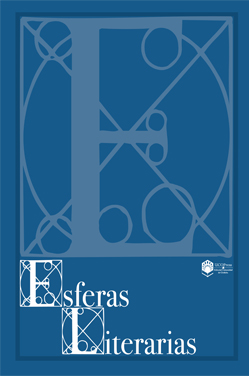Adaptation and Transformation of the Victorian Ghost Story: Traces of Intertextuality in Alejandro Amenábar's «The Others» and Juan Antonio Bayona's «The Orphanage»
Main Article Content
Abstract
A series of films by Spanish directors from the beginning of the 21st century, such as Alejandro Amenábar’s The Others (2001) and Juan Antonio Bayona’s The Orphanage (2007), evoke as well as recreate the Victorian ghost story. Both cinematic works present intertextual links between them, since they are grounded in the nineteenth-century gothic tradition, particularly insofar as these two films portray dysfunctionalities within the family and anxieties arising from motherhood. Despite their parallelisms, each film illustrates different varieties in their approach to the contemporary fantastic genre, like the neofantastic, by means of which the real world is perceived as a mask which conceals an alternative reality, and the postfantastic, in which the will of calling into question narratological codes leads to the disruption of differences between both realities. This article approaches these two contemporary horror films in order to analyse their contribution to adapting and transforming the Victorian ghost story, the intertextual links between them on the basis of the nineteenth-century gothic tradition, and the different trends within the fantastic genre that each film represents.
Downloads
Article Details

This work is licensed under a Creative Commons Attribution-NonCommercial-NoDerivatives 4.0 International License.
References
Alazraki, Jaime (1990), «¿Qué es lo neofantástico?», Mester, XIX, 2, pp. 21-33. DOI: https://doi.org/10.5070/M3192014104
Amenábar, Alejandro (2001), Los otros, guion de Alejandro Amenábar, España / Francia / Estados Unidos, Producciones del Escorpión / Sogecine / Cruise-Wagner Productions.
Arias, Rosario and Patricia Pulham (2009), «Introduction», in Rosario Arias and Patricia Pulham (eds.), Haunting and Spectrality in Neo-Victorian Fiction: Possessing the Past, Basingstoke, Palgrave Macmillan. DOI: https://doi.org/10.1057/9780230246744
Bachelard, Gastón (2000), La poética del espacio, Buenos Aires, Fondo de Cultura Económica.
Baudrillard, Jean (1981), Simulacra and Simulation, Ann Arbor, The University of Michigan Press.
Bayona, Juan Antonio (2007), El orfanato, guion de Sergio G. Sánchez, España / México, Rodar y Rodar.
Briggs, Julia (2000), «The Ghost Story», in David Punter (ed.), A Companion to the Gothic, Oxford, Blackwell, pp. 122-131. DOI: https://doi.org/10.1111/b.9780631206200.2001.00012.x
Carroll, Noël (1990), The Philosophy of Horror or Paradoxes of the Heart, New York / London, Routledge.
Cirlot, Juan Eduardo (2019), Diccionario de símbolos, Madrid, Siruela.
Derrida, Jacques (1994), Specters of Marx, the State of the Debt, the Work of Mourning and the New International, London, New York, Routledge.
Fincher, Max (2016), «The Sublime», in William Hughes, David Punter and Andrew Smith (eds.), The Encyclopedia of the Gothic, Oxford, Blackwell, pp. 655-658.
Freeman, Nick (2016), «Ghost Stories», in William Hughes, David Punter and Andrew Smith (eds.), The Encyclopedia of the Gothic, Oxford, Blackwell, pp. 277-281.
Freud, Sigmund (1925), «The Uncanny», The Standard Edition of the Complete Psychological Works of Sigmund Freud, XVII, London, The Hogarth Press, pp. 219-252.
García, Alejandra (2021), «Entrevista a Alejandro Amenábar», FlixOlé, 11 de agosto, <https://www.audiovisual451.com/entrevista-en-exclusiva-a-alejandro-amenabar-por-el-20o-aniversario-de-los-otros/>
Genette, Gérard (1989), Palimpsestos: la literatura en segundo grado, Madrid, Taurus.
González Dinamarca, Rodrigo Ignacio (2015), «Los niños monstruosos en El orfanato de Juan Antonio Bayona y Distancia de rescate de Samanta Schweblin», Brumal: Revista de investigación sobre lo fantástico, III, 2, pp. 89-106. DOI: https://doi.org/10.5565/rev/brumal.249
Hartnell-Mottram, Elaine (2016), «Domestic Gothic», in William Hughes, David Punter and Andrew Smith (eds.), The Encyclopedia of the Gothic, Oxford, Blackwell, pp. 184-187.
Heilmann, Ann (2009), «The Haunting of Henry James: Jealous Ghosts, Affinities, and The Others», in Rosario Arias and Patricia Pulham (eds.), Haunting and Spectrality in Neo-Victorian Fiction: Possessing the Past, Basingstoke, Palgrave Macmillan, pp. 111-130. DOI: https://doi.org/10.1057/9780230246744_6
Hill, Susan (1983), «Introduction», in Susan Hill (ed.), Ghost Stories, London, Hamish Hamilton, pp. 9-15.
Hutcheon, Linda (2006), A Theory of Adaptation, London, New York, Routledge. DOI: https://doi.org/10.4324/9780203957721
Joosen, Vanessa (ed.) (2018), Connecting Childhood and Old Age in Popular Media, Jackson, University Press of Mississippi. DOI: https://doi.org/10.14325/mississippi/9781496815163.001.0001
Jung, Carl G. (1993), Las relaciones entre el yo y el inconsciente, Barcelona, Paidós.
Jurado, Nancy (2022), «Película: El orfanato», Revista IMX, 2 de septiembre, <https://revistaimx.com/pelicula-el-orfanato/sociales>.
King, Stephen (2000), Danse Macabre, London, Warner Books.
Kristeva, Julia (1978), Semiótica 1, Madrid, Fundamentos.
Kristeva, Julia (1982), Powers of Horror: An Essay on Abjection, Leon Roudiez (trad.), New York, Columbia University Press.
Levinas, Emmanuel (2002), Totalidad e infinito: ensayo sobre la exterioridad, Daniel E. Guillot (ed.), Salamanca, Ediciones Sígueme.
Llewellyn, Mark (2008), «What Is Neo-Victorian Studies?», Neo-Victorian Studies, I, 1, pp. 164-185.
Lyotard, Jean-François (1979), The Postmodern Condition: A Report on Knowledge, Minneapolis, University of Minnesota Press.
Macedo Rodríguez, Alfonso (2008), «La intertextualidad: cruce de disciplinas humanísticas», Xihmai, III, 5, pp. 1-9.
Moers, Ellen (1976), Literary Women, London, Women’s Press.
Moran, Maureen (2006), Victorian Literature and Culture, London, Continuum.
Nelson, Claudia (2012), Precocious Children and Childish Adults: Age Inversion in Victorian Literature, Baltimore, The Johns Hopkins University Press. DOI: https://doi.org/10.1353/book.14635
Rank, Otto (1914), The Double: A Psychoanalytic Study, Herbert Tucker (ed.) (trans.), Chapel Hill, University of North Carolina Press.
Rodero, Jesús (2006), La edad de la incertidumbre: un estudio del cuento fantástico del siglo XX en Latinoamérica, Nueva York, Peter Lang.
Salgado, Diego (2007), «El orfanato: el miedo a perder lo que amamos», FanDigital, 10 de octubre, <http://www.fanzinedigital.com/cine/3438_1-El_Orfanato.html>.
Shiller, Dana (1997), «The Redemptive Past in the Neo-Victorian Novel», Studies in the Novel, XXIX, 4, pp. 538-560.
Stevens, David (2010), The Gothic Tradition, Cambridge, Cambridge University Press.
Todorov, Tzvetan (1981), Introducción a la literatura fantástica, México, Editions du Seuil.
Wolfreys, Julian (ed.) (2002), Victorian Hauntings: Spectrality, Gothic, the Uncanny and Literature, Basingstoke, Palgrave Macmillan. DOI: https://doi.org/10.1007/978-1-4039-1358-6
Wood, Robin (1996), «An Introduction to the American Horror Film», in Barry Keith Grant (ed.), Planks of Reason: Essays on the Horror Film, Lanham, London, The Scarecrow Press, pp. 164-199.




